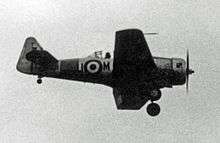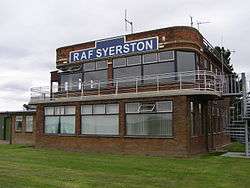RAF Syerston
| RAF Syerston | |||||||||||||
|---|---|---|---|---|---|---|---|---|---|---|---|---|---|
| Near Newark-on-Trent, Nottinghamshire in England | |||||||||||||
|
Tower in 2006 | |||||||||||||
 EGXY Shown within Nottinghamshire | |||||||||||||
| Coordinates | 53°01′24″N 000°54′42″W / 53.02333°N 0.91167°WCoordinates: 53°01′24″N 000°54′42″W / 53.02333°N 0.91167°W | ||||||||||||
| Type | Royal Air Force station | ||||||||||||
| Site information | |||||||||||||
| Owner | Ministry of Defence | ||||||||||||
| Operator | Royal Air Force | ||||||||||||
| Site history | |||||||||||||
| Built | 1939/40 | ||||||||||||
| In use | 1940-Present | ||||||||||||
| Airfield information | |||||||||||||
| Identifiers | ICAO: EGXY | ||||||||||||
| Elevation | 69 metres (226 ft) AMSL | ||||||||||||
| |||||||||||||
RAF Syerston (ICAO: EGXY) is a Royal Air Force station in the parish of Flintham, near Newark, Nottinghamshire. It was used as a bomber base during the Second World War.
History
Bomber Command
Syerston was built as part of the bomber expansion in the late 1930s, but did not open until 1 December 1940. The first aircraft were Vickers Wellingtons crewed by Polish flyers. In July 1941 they were replaced by members of the RCAF flying Handley-Page Hampdens. From December 1941 until 5 May 1942, the base was closed whilst a concrete runway was built with two T2 hangars. When it re-opened, it became part of No. 5 Group. In 1942 several squadrons of Avro Lancaster aircraft arrived. In 1943 Bill Reid of 61 Squadron won a Victoria Cross on a mission flown from Syerston.
On 17 November 1943 the operational squadrons departed, and the station was used for bomber crew training, led by Captain Robert White. It became known as the Lancaster Finishing School in January 1944. From November 1943 to July 1944 there was also a Bombing and Gunnery Defence Training Flight in attendance with several Wellingtons, Spitfires, Hurricanes, plus a few Martinet tug aircraft, all employed in brushing up the skills of air gunners on air-to-air exercises. The LFS left on 1 April 1945, with No. 49 Squadron arriving from RAF Fulbeck later in the month who only had one operation before leaving to RAF Mepal in September.
Post-war use

On 25 October 1945, the base became part of Transport Command with a Heavy Conversion Unit arriving from RAF Leicester East, which stayed until 5 January 1948 when it moved to RAF Dishforth. Syerston was taken over by Flying Training Command on 1 February 1948 when No.22 Flying School arrived from RAF Ouston which trained pilots for the Fleet Air Arm (FAA). Other nearby airfields used for flying circuits were RAF Newton, RAF Wymeswold and Tollerton airfield (now Nottingham Airport). The training school became No. 2 Flying Training School RAF in 1955. In November 1953, Percival Provosts began being used, being replaced by the (Hunting Percival) Jet Provost in 1959. The flying training school was disbanded on 16 January 1970 when the need for pilots had diminished, and the station lay vacant.
Incidents
On 20 September 1958, the prototype Avro Vulcan VX770 crashed during a fly past at RAF Syerston Battle of Britain At Home display.

- A Rolls Royce test pilot was authorized to fly VX770 on an engine performance sortie with a fly past at the Battle of Britain display. The briefing was for the pilot to fly over the airfield twice at 200–300 ft (61–91 m), flying at a speed of 250–300 kn (460–560 km/h; 290–350 mph). The Vulcan flew along the main 07/25 runway (now 06/24 due to magnetic shift) then started a roll to starboard and climbed slightly. Very shortly a kink appeared in the starboard mainplane leading edge followed by a stripping of the leading edge of the wing. The starboard wingtip then broke followed by a collapse of the main spar and wing structure. Subsequently, the Vulcan went into a dive and began rolling with the starboard wing on fire and struck the ground at the taxiway of the end of runway 07. Three occupants of a controllers' caravan were killed by debris, a fourth being injured. All the crew of the Vulcan were killed. Proposed causes of the accident have included pilot error, fatigue failure and inadequate maintenance. See here for more details.[1]
Current units
In January 1975 the Royal Air Force Central Gliding School and 644 Volunteer Gliding Squadron moved to Syerston, and have been there since, with 643 Volunteer Gliding Squadron also being based at Syerston since 10 Oct 1992. This was only meant to be a short term stay. Most of the buildings were demolished in 1997.
From 1990 Nottingham University Gliding Club, when affiliated with the Four Counties Gliding Club, used the airfield until 2004, when both moved to RAF Barkston Heath. In 2005, Nottingham University Gliding Club affiliated itself to Cranwell Gliding Club at RAF Cranwell, when Four Counties Gliding Club moved to RAF Wittering.
In 2013, the base was used for Exercise Decisive Edge as part of the RAF's Initial Officer Training
Operational units and aircraft
Current Units
- HQ, No. 2 Flying Training School RAF
- Central Gliding School - Vigilant T.1/Viking T.1
- 644 Volunteer Gliding Squadron - Viking T.1
Historical Units
- No. 49 Squadron RAF (22 April 1945 – 28 September 1945) - Avro Lancaster I & III
- No. 61 Squadron RAF (5 May 1942 – 17 November 1943) - Avro Lancaster I, II & III
- No. 106 Squadron RAF (1 October 1942[2] - 17 November 1943) - Avro Lancaster I & III
- No. 304 Squadron RAF (December 1940-20 July 1941) - Vickers Wellington IC
- No. 305 Squadron RAF (December 1940-20 July 1941) - Vickers Wellington IC
- No. 408 Squadron RCAF (July 1941-8 December 1941) - Handley Page Hampden
- 643 Volunteer Gliding Squadron - merged with 644 VGS in 2012
References
- ↑ BBC video 50th Anniversary of Vulcan crash
- ↑ Gibson, G, Enemy Coast Ahead
External links
| Wikimedia Commons has media related to RAF Syerston. |
- Airport information for EGXY at World Aero Data. Data current as of October 2006.
- Station history
- RAF website
- 643 VGS
- 644 VGS
- Central Gliding School
